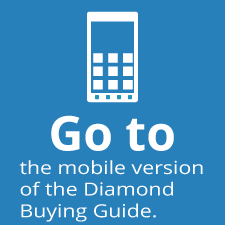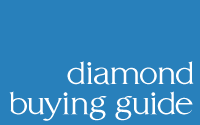Introduction to Fancy Colored Diamonds
 While there's no question that the most popular color of diamonds sold for engagement rings is white (or colorless),
fancy colored diamonds are a spectacular alternative that is gaining in popularity (especially as we see more celebrities
showing off their colorful engagement rings).
While there's no question that the most popular color of diamonds sold for engagement rings is white (or colorless),
fancy colored diamonds are a spectacular alternative that is gaining in popularity (especially as we see more celebrities
showing off their colorful engagement rings).
The Hope Diamond (shown to the left)
is probably the most famous fancy colored diamond in the world. In 1988, the Gemological Institute of America
examined the Hope Diamond and graded the color "Fancy dark grayish-blue."
Fair warning for anyone considering a fancy colored diamond: they almost always cost more than their white counterparts -- and some
colors cost considerably more.
Do the "4 Cs of Diamond Grading" still apply?
When evaluating fancy colored diamonds, you definitely want to be familiar with the
4 Cs of diamond grading, but while I normally recommend giving the cut quality
top consideration, not so with fancy colored diamonds.
Unsurprisingly, with fancy colored diamonds you look to the color grade first. The deepness or richness of color not only has the
greatest impact on appearance, but also price. The criteria that are typically considered when purchasing a colorless diamond
are less important because, ultimately, you want a diamond with evenly saturated color.
The higher the saturation (or intensity of color), the more rare (and costly) the diamond.
Unlike color grading for white diamonds, fancy colored diamonds are graded in order of increasing intensity:
starting from Faint, Very Light, Light, Fancy Light, Fancy, Fancy Intense, Fancy Vivid,
Fancy Dark and finally, Fancy Deep.

- Red,
Pink,
Green, and
Blue Diamonds: These colors (and their variations, such as mauve) are the rarest colors. As you
probably already know, the rarer the diamond, the higher the price -- so these diamonds (particularly with intense colors) are the most costly.
-
Yellow Diamonds: Yellow diamonds are the second most common fancy colored diamond and are one of the most
popular choices due to the fact that they offer a tremendous value when compared to other colors such as pink and red.
-
Brown Diamonds: While they are the most common fancy colored diamond (and, all else being equal, the least expensive),
they are not the most popular. Let's face it, "brown" is not a popular color in the world of fashion. In the modern world,
most brown diamonds have been relegated to industrial use (even though they have been used in jewelry as far back as Second-century Rome).
All of that changed in the 1980s when the
Argyle Diamond Mine (Australia) started producing
a large number of brown diamonds and sellers started marketing the colors as "champagne," "cognac," and even "chocolate."
Personally, I'm a fan of brown diamonds (though I also admit to preferring the upscale "champagne" and "cognac" monikers). For me,
they have an earthiness that is both interesting and beautiful.
What about less expensive colored gemstones?
A common question that arises when people start looking at fancy colored diamonds is, "why wouldn't I opt for a much less expensive
colored gemstone, such as a sapphire?"
It's a good question. Except when comparing colored diamonds side-by-side with other colored gemstones,
many people can't tell the difference between a yellow diamond and a yellow sapphire.
For example, look at these Google image searches for
yellow diamonds and
yellow sapphires -- if I hadn't told you which search was for which gemstone, do you think you could have properly identified
the stones? Most people can't. (Notice I said "most," some people can absolutely identify a sapphire versus a diamond.)
So, if most people can't tell the difference, why not go for the less expensive option? Here are the most popular
arguments on the topic.
- A diamond is a better investment
Let me be blunt. If you're paying retail prices, diamonds are not a "good" investment. Investments earn money over time. But when
you sell that diamond you purchased at a retail price, you will most likely sell it at closer to a wholesale price. In other words, for less
than you paid for it. So let's just toss this argument to the side and move on to the arguments that have merit.
- Sentimental attachments... and rebellions
In contemporary times, the diamond is the most popular gemstone for engagement rings. For many people, that is the deciding
factor -- whether they want to go with tradition or against the mainstream, it's such a personal choice that I can't make a recommendation
one way or the other.
Purchase what makes you (or your bride) happy.
- Hardness and chipping
A common argument for choosing a diamond for jewelry worn on a daily basis is that the diamond is the hardest natural
gemstone and, therefore, should hold up to daily wear better than any other gemstone. Which is true, but...
As you can see on this
Mohs Scale of Mineral Hardness, gemstones such as ruby and sapphires fall just one point below diamond (which is a "10" on the Mohs Scale).
Yes, it's possible to chip a sapphire or ruby, but, I'm sad to tell you, it's also possible to chip a diamond.
The fact is that gemstones, regardless of their hardness can be chipped, cracked, and shattered.
For an everyday ring, yes, my first choice would be the hardest (diamond), but I wouldn't hesitate to wear a ruby or sapphire on a daily basis
(keeping in mind, that any of the three might chip).
However, it's unlikely that I would drop below the ruby and sapphire's Mohs rating (nine) for an everyday ring -- meaning I would avoid stones such as spinel (8), topaz (8), and emerald (7.5).
- The Sparkle Factor
This is the one factor where the diamond has a distinct advantage over other gemstones. A diamond's sparkle is, in large part, determined by the quality
of the diamond's cut, but it's also heavily influenced
by how a diamond refracts light.
The "Refractive Index" is a measure of how a material slows and bends light -- the higher the ranking on the Refractive Index, the more potential
for the material to "bounce" the light back to the observer (creating "sparkle").
The diamond has an "RI" of 2.417 (the index starts at "1"). For comparison, here are some other popular gemstones and their ranking on the Refractive Index.
- Sapphire: 1.76
- Ruby: 1.76
- Peridot: 1.65
- Topaz: 1.61
- Emerald: 1.57
- Citrine: 1.55
When it comes to "sparkle" all other gemstones are fighting for second place -- diamond is the clear winner.
Finally, what you should know about artificially changing a diamond's color --
before you buy
The rarest and most valuable fancy colored diamonds are the ones that are natural -- the color you see is the color the diamond was before it
was mined.
But in addition to natural fancy colored diamonds, you'll also find "color enhanced diamonds."
I know. There's a lot of information here and now you have to worry about people changing a diamond's color? Yes. And the reason you need
to think about color "enhancements" is because those enhancements can drastically change the value of the diamond and you don't want to
pay retail prices for a natural stone when what you're actually receiving is a mediocre stone with an applied film coating.
There are three primary methods for changing the color of a diamond: irradiation, the application of high pressure
and high temperature, and the application of a coating. The first two are generally considered permanent changes to the diamond,
but the application of a coating, which can be scratched and worn over time, is considered impermanent. So if you do opt for
a color enhanced diamond, I would strongly recommend against one with an applied coating.
If a dealer does not clearly document (don't take the word of a sales clerk) whether the diamonds they sell are color enhanced,
don't give them your business. There are reputable dealers who sell enhanced diamonds -- what make them reputable is that they don't
hide the fact the diamonds have been coated, irradiated, or heat treated (plus they also recognize that enhanced diamonds command a lower price
than their natural counterparts).
Reputable dealers have no problem answering questions about color enhancement. For example, all of the diamonds offered by
Blue Nile possess natural color and "are never exposed to artificial coloring techniques such as coating, irradiation, or the application of
high pressure and high temperature." View Blue Nile’s collection of
natural fancy colored diamonds.
Where to Buy Fancy Colored Diamonds
|

|


 While there's no question that the most popular color of diamonds sold for engagement rings is white (or colorless),
fancy colored diamonds are a spectacular alternative that is gaining in popularity (especially as we see more celebrities
showing off their colorful engagement rings).
While there's no question that the most popular color of diamonds sold for engagement rings is white (or colorless),
fancy colored diamonds are a spectacular alternative that is gaining in popularity (especially as we see more celebrities
showing off their colorful engagement rings).

